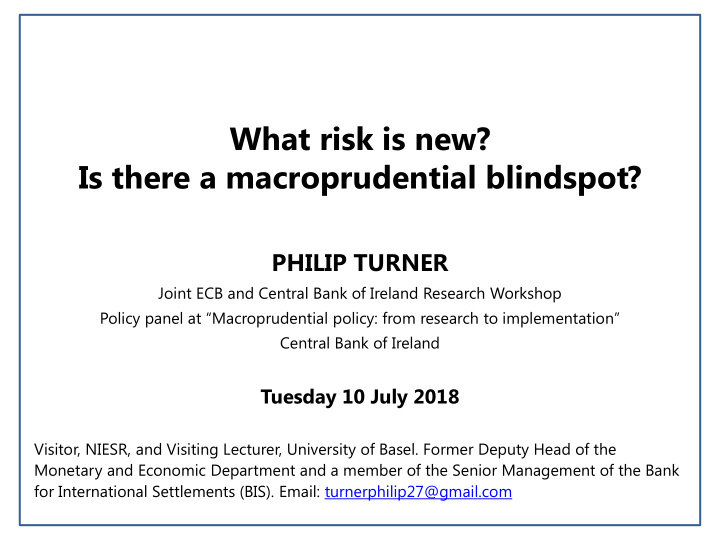



What risk is new? Is there a macroprudential blindspot? PHILIP TURNER Joint ECB and Central Bank of Ireland Research Workshop Policy panel at “Macroprudential policy: from research to implementation” Central Bank of Ireland Tuesday 10 July 2018 Visitor, NIESR, and Visiting Lecturer, University of Basel. Former Deputy Head of the Monetary and Economic Department and a member of the Senior Management of the Bank for International Settlements (BIS). Email: turnerphilip27@gmail.com
WHO CARES ABOUT ASSET PRICE INCREASES? NO ONE? Not quite … what has driven asset prices up? would a reversal lead to a disruptive collapse? Dangerous unknown is interest rate risk in banks, insurance companies and other financial firms … how they react when rates rise could be destabilising This is a macroprudential blindspot 2
Decomposition of the 10-year world bond yield
INTEREST RATE RISK? Long-term “world” interest rate around zero Monetary policy with radical policies (negative short rates, CB purchases of bonds etc) The world term premium in 10-year bonds fell from plus 1% in early 2011 to minus 1% by 2016 … a reduction of 200 basis points . 4
Not just monetary policy – also new regulations Recent regulations have: (a) Driven banks and institutional investors to hold more government bonds … Accounting rules, Solvency 2, Basel III (Turner (2017)). Transitional effects are strong as firms adapt to new rules …. but will weaken in a new steady state (b) Led to a pro-cyclical increase in bond duration as LT rates decline 5
Regulations force increased holdings of govt bonds Basel III : (1) allows govt bonds of any maturity to count as a liquid asset (in the past, only short-term bills counted); (2) once again, no agreement on a Pillar 1 capital charge for interest rate risk in the Banking Book . Solvency II, accounting rules etc: Firms investing on behalf of others forced to reduce credit risk exposures but at the price of increasing interest rate risk via inceased holdings of longer- dated bonds. 6
Have regulations made bonds demand more pro- cyclical? Several mechanisms for pro-cyclical increase in duration of aassets Buy longer-dated paper to maintain yield o React to expectations of even lower future yields o Rise in the PDV of long-dated liabilities. o If pro-cyclical, any initial shock to LT rates is magnified Increased stock + longer average maturity = Portfolios more sensitive to changes in the LT rate Where would losses fall? Not known! Bond markets are more illiquid: price movements could be large, discontinuous and overshoot equilibrium 7
Macroprudential tool-kit is inadequate for interest rate risk Banks. No Pillar 1 capital charge for interest rate risk. Liquidity rules lead banks to hold large stocks of liquid assets but should be contingent and adapt to the market swings. Non-banks . Leverage and maturity mismatches . Has macroprudential applied to banks shifted risks to non-banks (Cizel et al (2016))? Market functioning. Innovations (e.g., rise of bond funds, increased use of interest rate derivatives) and new infrastructures (e.g., clearing houses) require new forms of macroprudential oversight 8
Conclusion Monetary and regulatory policies have created new interest rate risk exposures… a “dangerous unknown" in the financial system. Review how far regulations/supervisory practices have inadvertently encouraged large but non-transparent interest rate risk exposures in financial firms Macroprudential policies do not address interest rate risk exposures and the associated liquidity risks (Constâncio (2017) … echoed by Knot (2018) and Villeroy de Galhau (2018) 9
References Cizel, Janko, Jon Frost, Aerdt Houban, Peter Wierts (2016): “ Effective macroprudential policy: cross-section substitution from price and quantity measures” IMF Working Paper WP/16/94. April Constâncio, Vitor: (2017): “The evolving risk landscape in the euro area” Speech at Banco do Portugal conference on Financial Stability, 17 October Hördahl, Peter, Jhuvesh Sobrun and Philip Turner (2016) : “Low long-term interest rates as a global phenomenon”, BIS Working Papers , no 574, August. Knot, Klaas (2018): ”Regulating non-bank finance: options and implications”. Speech at the FRS launch at the Banque de France. 25 April Turner, Philip (2010): “Did central banks cause the last financial crisis? Will they cause the next?” NIESR Discussion Paper no 484 December Villeroy de Galhau, François (2018): “Between “shadow” banking and an angelic vision of the market: towards a balanced development of non-bank finance” Banque de France Financial Stability Review. no 22. April. pp 7-10. 10
Recommend
More recommend